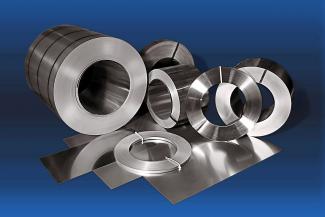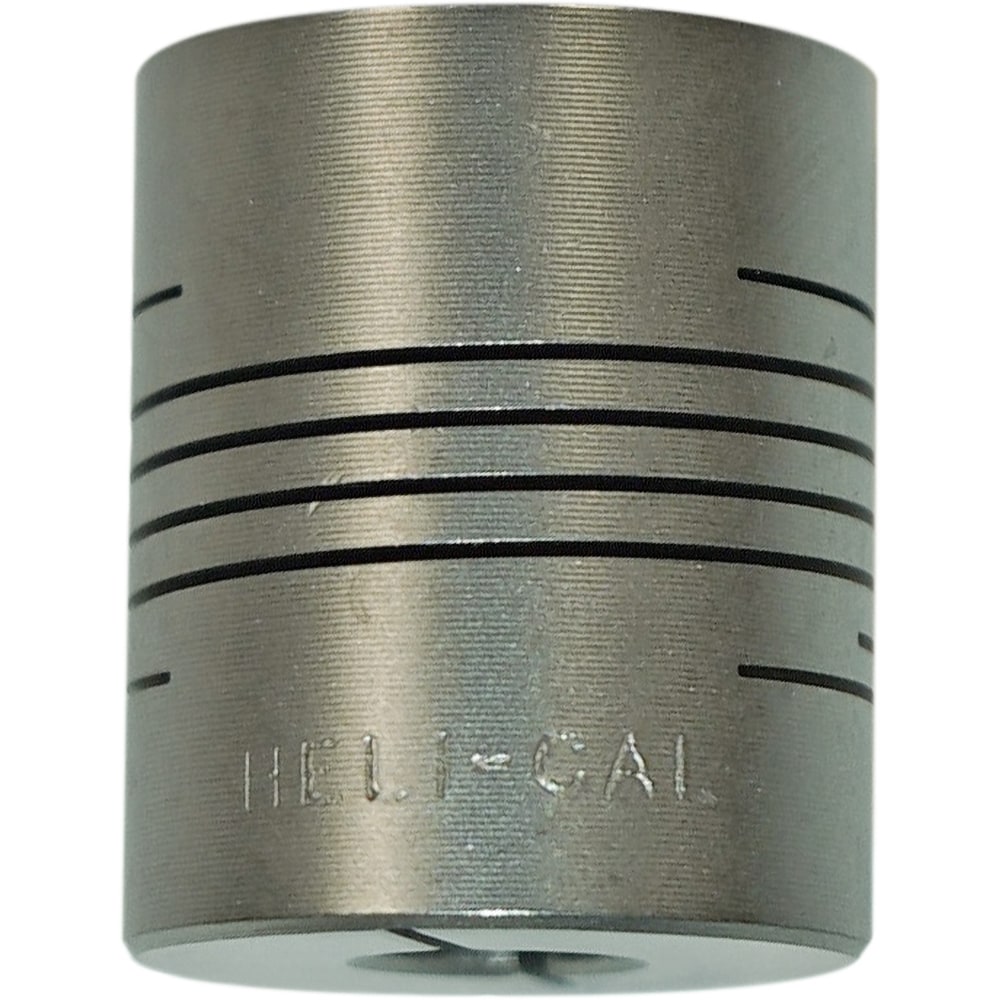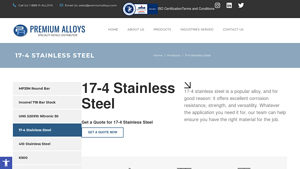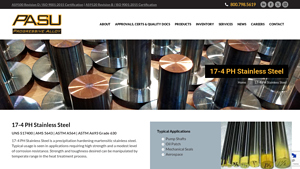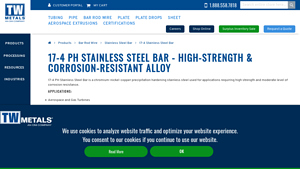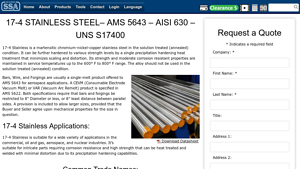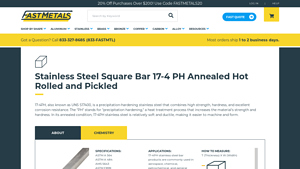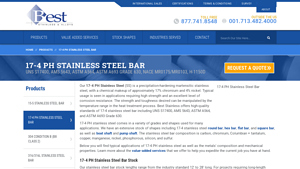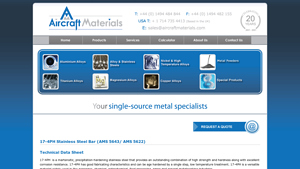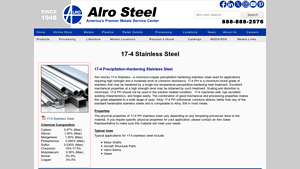17 4 Ph Cres Guide: Type, Cost, Top List…
Introduction: Navigating the Global Market for 17 4 ph cres
Navigating the global market for 17-4 PH CRES (Corrosion-Resistant Steel) presents a unique challenge for international B2B buyers, particularly those in Africa, South America, the Middle East, and Europe. With its exceptional strength, corrosion resistance, and versatility, 17-4 PH is a preferred choice in demanding industries such as aerospace, oil and gas, and chemical processing. However, sourcing the right grade and understanding the nuances of material specifications can be daunting.
This comprehensive guide addresses the complexities of selecting 17-4 PH CRES by covering essential topics such as the various types and grades available, their specific applications, and how to effectively vet suppliers. Additionally, we delve into cost considerations and market trends, providing insights that empower B2B buyers to make informed purchasing decisions.
With the right knowledge, businesses can not only enhance their operational efficiency but also gain a competitive edge in their respective markets. Whether you’re in Nigeria or Brazil, this guide serves as a valuable resource to navigate the intricacies of sourcing 17-4 PH CRES, ensuring that you select the optimal materials for your unique requirements while minimizing risk and maximizing value.
Understanding 17 4 ph cres Types and Variations
| Type Name | Key Distinguishing Features | Primary B2B Applications | Brief Pros & Cons for Buyers |
|---|---|---|---|
| H900 | High tensile strength, excellent hardness | Aerospace, oil and gas, chemical processing | Pros: Exceptional strength; Cons: Limited ductility at high temperatures. |
| H1025 | Good balance of strength and corrosion resistance | Pump shafts, mechanical seals | Pros: Versatile; Cons: Moderate fatigue strength compared to H900. |
| H1075 | Enhanced toughness with moderate corrosion resistance | Marine applications, automotive parts | Pros: Good formability; Cons: Lower yield strength than H900. |
| H1150 | Lower hardness, improved ductility | Food processing, medical equipment | Pros: Excellent weldability; Cons: Reduced strength in high-stress applications. |
| H1150D | Optimized for ductility and toughness | Structural components, aerospace | Pros: Great for applications requiring fatigue resistance; Cons: Not suitable for high-temperature uses. |
What are the characteristics of H900 17-4 PH stainless steel?
H900 is renowned for its high tensile strength and exceptional hardness, making it a preferred choice in industries that demand robust materials, such as aerospace and oil and gas. Its properties enable it to withstand extreme conditions, although it may sacrifice some ductility at elevated temperatures. Buyers should consider H900 for applications requiring high strength, but they must also assess whether the reduced ductility meets their project specifications.
How does H1025 compare in versatility for B2B applications?
H1025 offers a balanced combination of strength and corrosion resistance, making it suitable for various applications, including pump shafts and mechanical seals. Its versatility allows it to perform well in moderate stress environments, but it has a lower fatigue strength compared to H900. B2B buyers can benefit from H1025’s adaptability, but they should evaluate the specific requirements of their applications to ensure it meets performance expectations.
What advantages does H1075 provide for marine applications?
H1075 is characterized by enhanced toughness while maintaining moderate corrosion resistance, making it an excellent option for marine applications and automotive parts. Its good formability allows for ease of manufacturing, but it has a lower yield strength than H900. Buyers in sectors where high toughness is crucial should consider H1075, but they must also weigh its lower strength against their operational needs.
Why is H1150 a good choice for food processing and medical equipment?
H1150 is known for its lower hardness and improved ductility, making it ideal for applications in food processing and medical equipment where weldability is essential. While it offers excellent formability, its reduced strength may not be suitable for high-stress applications. B2B buyers should prioritize H1150 for projects requiring easy fabrication and corrosion resistance, but they should be cautious about its limitations in strength.
How does H1150D enhance fatigue resistance in structural components?
H1150D is optimized for ductility and toughness, making it suitable for structural components in aerospace and other demanding industries. Its design focuses on enhancing fatigue resistance, which is crucial for applications subject to repeated stress. However, it may not perform well in high-temperature environments. Buyers should consider H1150D for applications where durability and fatigue resistance are paramount, while also ensuring it aligns with temperature requirements.
Key Industrial Applications of 17 4 ph cres
| Industry/Sector | Specific Application of 17 4 ph cres | Value/Benefit for the Business | Key Sourcing Considerations for this Application |
|---|---|---|---|
| Aerospace | Aircraft components and structural parts | High strength-to-weight ratio and excellent corrosion resistance enhance aircraft performance and longevity. | Ensure compliance with aerospace standards and certifications. Consider suppliers with proven track records in quality assurance. |
| Oil and Gas | Pump shafts and mechanical seals | Enhanced durability and resistance to harsh environments reduce maintenance costs and downtime. | Evaluate the alloy’s compatibility with specific fluids and temperatures. Verify supplier’s ability to meet industry specifications. |
| Chemical Processing | Valve components and piping systems | Superior corrosion resistance ensures safety and reliability in chemical handling processes. | Look for suppliers offering custom fabrication and heat treatment services to meet specific application needs. |
| Food Processing | Equipment for food preparation and storage | Non-reactive properties ensure food safety and compliance with health regulations. | Source from suppliers with certifications for food-grade materials and hygienic processing capabilities. |
| Defense and Military | Weaponry and protective gear | High toughness and strength in extreme conditions enhance operational effectiveness and safety. | Confirm adherence to military specifications and standards. Evaluate suppliers for reliable delivery and support services. |
How is 17 4 PH CRES Used in Aerospace Applications?
In the aerospace sector, 17 4 PH CRES is utilized for manufacturing aircraft components such as landing gear, structural parts, and engine components. Its high strength-to-weight ratio is crucial for improving fuel efficiency and performance while maintaining safety standards. International buyers, particularly from regions like Africa and South America, should prioritize suppliers who comply with stringent aerospace certifications to ensure reliability and performance in critical applications.
What Role Does 17 4 PH CRES Play in Oil and Gas Industries?
In the oil and gas industry, 17 4 PH CRES is commonly employed in pump shafts and mechanical seals that operate in extreme environments. The alloy’s exceptional durability and resistance to corrosive substances help mitigate the risk of equipment failure and costly downtime. Buyers from the Middle East and Europe should focus on sourcing from suppliers who understand the specific operational requirements and can provide materials tailored to their unique conditions.
How is 17 4 PH CRES Beneficial for Chemical Processing?
Within chemical processing, 17 4 PH CRES is favored for valve components and piping systems due to its superior corrosion resistance. This characteristic ensures that the materials can safely handle aggressive chemicals without compromising structural integrity. Buyers in this sector should seek suppliers who can offer custom fabrication services and demonstrate expertise in meeting industry-specific standards for chemical compatibility.
Why is 17 4 PH CRES Essential in Food Processing?
In food processing applications, 17 4 PH CRES is used in equipment designed for food preparation and storage due to its non-reactive properties. This ensures that the alloy does not contaminate food products, adhering to health regulations and safety standards. B2B buyers, especially from regions like Nigeria and Brazil, should prioritize suppliers that hold food-grade certifications and have robust hygienic processing capabilities to ensure compliance and safety.
How is 17 4 PH CRES Applied in Defense and Military?
In defense applications, 17 4 PH CRES is used for weaponry and protective gear, where high toughness and strength are critical. The alloy’s ability to perform under extreme conditions enhances the effectiveness and safety of military operations. Buyers in this sector should confirm that suppliers adhere to military specifications and can provide reliable support and delivery to meet operational demands.
3 Common User Pain Points for ’17 4 ph cres’ & Their Solutions
Scenario 1: Navigating Corrosion Challenges in Harsh Environments
The Problem: B2B buyers often face significant challenges in sourcing materials that can withstand harsh environmental conditions, particularly in industries such as oil and gas, chemical processing, and aerospace. The risk of corrosion can lead to equipment failure, safety hazards, and costly downtime. Buyers need materials that not only meet high strength requirements but also exhibit exceptional corrosion resistance to avoid these issues.
The Solution: To effectively address corrosion challenges, it’s essential to specify 17-4 PH stainless steel with an appropriate heat treatment condition that enhances its resistance to corrosive environments. Buyers should work closely with suppliers to understand the specific conditions their materials will face, such as temperature fluctuations and exposure to chemicals. Opt for H900 or H1150D conditions, as these provide superior toughness and corrosion resistance. Additionally, consider using protective coatings or surface treatments to further enhance corrosion resistance. Regular maintenance checks and a robust materials management strategy can also mitigate corrosion risks over time.
Scenario 2: Struggling with Machinability and Fabrication
The Problem: Many manufacturers encounter difficulties when machining and fabricating 17-4 PH stainless steel due to its hardness, especially after heat treatment. This can lead to increased tool wear, longer production times, and higher operational costs. Buyers often find that their fabrication processes are not optimized for this material, resulting in inefficiencies and potential quality issues in the final products.
The Solution: To enhance machinability, it’s crucial to choose the right heat treatment condition based on the intended machining process. For instance, selecting the H1075 condition can provide a balance between hardness and workability, making machining more manageable. Incorporating high-quality cutting tools specifically designed for stainless steel can also significantly improve machining efficiency. Furthermore, adjusting machining parameters such as feed rates and speeds, and using appropriate coolants can reduce tool wear and improve surface finish. Collaborating with experienced machinists who understand the nuances of working with 17-4 PH can lead to better outcomes and reduced operational costs.
Scenario 3: Achieving Required Mechanical Properties for Specific Applications
The Problem: B2B buyers often struggle to find materials that meet precise mechanical property specifications for critical applications, such as aerospace components or medical devices. The challenge lies in ensuring that the selected grade of 17-4 PH stainless steel can deliver the necessary tensile strength, yield strength, and ductility for demanding operational environments. Inadequate material properties can compromise the safety and performance of the final products.
The Solution: To ensure that 17-4 PH stainless steel meets specific mechanical property requirements, buyers should engage in thorough communication with suppliers about their application needs. Clearly specify the desired mechanical properties and select the appropriate heat treatment condition that aligns with those requirements. For instance, if high tensile strength is critical, the H900 condition is ideal. Conducting material tests and certifications for each batch can also provide assurance that the properties meet industry standards. Additionally, leveraging simulation tools and software during the design phase can help predict how the material will perform under operational stresses, ensuring that the selected grade will meet or exceed the required specifications.
Strategic Material Selection Guide for 17 4 ph cres
What Are the Key Properties of 17-4 PH CRES Materials?
17-4 PH stainless steel is a versatile alloy known for its exceptional mechanical properties, including high strength and excellent corrosion resistance. It typically contains 17% chromium and 4% nickel, making it suitable for high-temperature applications, such as those found in the aerospace, oil and gas, and chemical processing industries. The material can withstand temperatures up to 600°F (316°C) and offers a range of hardness levels depending on the heat treatment process.
What Are the Pros and Cons of Using 17-4 PH CRES?
Key Properties
- Corrosion Resistance: 17-4 PH exhibits superior resistance to various corrosive environments, making it ideal for applications that involve exposure to harsh chemicals.
- Strength and Toughness: The alloy maintains its strength and toughness even at elevated temperatures, which is critical for applications in extreme conditions.
Pros
- Durability: The alloy’s high tensile strength and toughness provide durability, making it suitable for demanding applications.
- Customizability: 17-4 PH can be tailored through heat treatment to achieve specific mechanical properties, allowing for flexibility in design.
Cons
- Cost: Compared to standard stainless steels, 17-4 PH can be more expensive due to its alloying elements and processing requirements.
- Manufacturing Complexity: The need for specific heat treatment processes can complicate manufacturing, potentially leading to longer lead times.
How Does 17-4 PH CRES Impact Applications?
The choice of 17-4 PH stainless steel can significantly influence the performance of end products. For instance, its compatibility with corrosive media makes it a preferred choice for pump shafts in the oil and gas industry. However, buyers must consider the specific media their applications will encounter, as certain aggressive chemicals may still pose a risk to the alloy’s integrity.
What Should International B2B Buyers Consider When Sourcing 17-4 PH CRES?
International buyers, especially from regions like Africa, South America, the Middle East, and Europe, need to be aware of several factors:
- Compliance with Standards: Ensure that the material meets relevant international standards such as ASTM, DIN, or JIS. This is crucial for applications in regulated industries like aerospace or food processing.
- Local Availability: Assess the local supply chain for 17-4 PH to avoid delays and additional shipping costs. Understanding regional preferences can also guide procurement strategies.
- Technical Support: Seek suppliers who offer technical assistance and expertise in material selection and processing to optimize the performance of 17-4 PH in specific applications.
Summary Table of 17-4 PH CRES Materials
| Material | Typical Use Case for 17-4 PH CRES | Key Advantage | Key Disadvantage/Limitation | Relative Cost (Low/Med/High) |
|---|---|---|---|---|
| 17-4 PH Stainless Steel | Aerospace components, pump shafts | Excellent strength and corrosion resistance | Higher cost compared to standard steels | High |
| 17-4 PH Heat Treated | Oil and gas applications | Customizable properties through heat treatment | Manufacturing complexity | Medium |
| 17-4 PH Alloyed Steel | Chemical processing equipment | Superior toughness in extreme conditions | Limited availability in some regions | Medium |
| 17-4 PH Machined Parts | Food processing equipment | Good machinability and formability | Requires precise machining techniques | High |
This strategic material selection guide provides valuable insights for B2B buyers seeking to leverage the unique properties of 17-4 PH CRES in their applications. Understanding these factors will facilitate informed decision-making and enhance product performance across various industries.
In-depth Look: Manufacturing Processes and Quality Assurance for 17 4 ph cres
What Are the Main Stages of Manufacturing 17-4 PH CRES?
The manufacturing process of 17-4 PH stainless steel, a precipitation-hardening martensitic alloy, involves several critical stages: material preparation, forming, assembly, and finishing. Each stage is designed to ensure the alloy meets the stringent demands of various industries, including aerospace, oil and gas, and chemical processing.
How Is Material Prepared for 17-4 PH CRES?
The initial stage involves sourcing high-quality raw materials, which typically include chromium, nickel, copper, and other alloying elements. These materials must meet specific chemical composition standards to ensure the desired properties of 17-4 PH are achieved. After sourcing, the materials undergo melting and refining processes, often using electric arc furnaces. This step is crucial for eliminating impurities and achieving a homogeneous melt.
Once the alloy is melted, it is cast into ingots or billets. The casting process may employ methods such as continuous casting or sand casting, depending on the required dimensions and characteristics. After casting, the material is subjected to heat treatment, which is essential for developing the desired mechanical properties. Solution treatment and aging at controlled temperatures enhance the strength and toughness of the alloy.
What Techniques Are Used in the Forming Process?
The forming stage includes various techniques such as forging, rolling, and machining. Forging is particularly important for creating components that require superior mechanical properties. This process involves shaping the material while it is hot, which improves its strength through grain refinement.
After forging, the material may be rolled into sheets, plates, or bars, depending on the end-use requirements. CNC machining is often employed for precision parts, ensuring tight tolerances and surface finishes. Techniques such as wire EDM (Electrical Discharge Machining) and laser cutting are also commonly used for intricate designs.
How Is the Assembly Process Managed?
For applications that require multiple components, the assembly process plays a vital role. It typically involves welding or fastening techniques that must consider the specific properties of 17-4 PH. The alloy is known for its excellent weldability, allowing for various welding methods, including TIG (Tungsten Inert Gas) and MIG (Metal Inert Gas) welding.
Before assembly, it is crucial to perform thorough inspections to ensure that all components meet the necessary specifications. This step helps in identifying any defects or inconsistencies that could affect the performance of the final product.
What Finishing Techniques Are Employed for 17-4 PH CRES?
Finishing processes for 17-4 PH stainless steel include surface treatments such as polishing, passivation, and coating. Polishing enhances the aesthetic appeal and reduces surface roughness, while passivation improves corrosion resistance by removing free iron and other contaminants. Coatings may also be applied to enhance specific properties, such as wear resistance or additional corrosion protection.
These finishing techniques not only improve the functionality of the alloy but also ensure compliance with industry standards and customer specifications.
What Quality Assurance Measures Are Essential for 17-4 PH CRES?
Quality assurance (QA) is paramount in the manufacturing of 17-4 PH stainless steel. Adherence to international standards such as ISO 9001 ensures that manufacturers maintain consistent quality throughout the production process. For B2B buyers, understanding these standards and the associated quality control measures is crucial.
Which International and Industry-Specific Standards Should Be Considered?
ISO 9001 is a widely recognized standard that outlines the requirements for a quality management system. In addition to ISO standards, industry-specific certifications such as CE (Conformité Européenne) for European markets and API (American Petroleum Institute) for oil and gas applications are essential. These certifications indicate that the products meet rigorous safety and performance criteria.
What Are the Key Quality Control Checkpoints?
Quality control (QC) involves several checkpoints throughout the manufacturing process, typically categorized into Incoming Quality Control (IQC), In-Process Quality Control (IPQC), and Final Quality Control (FQC).
-
IQC: This stage involves the inspection of raw materials and components upon arrival at the manufacturing facility. Ensuring that these materials meet specified standards is crucial for the integrity of the final product.
-
IPQC: Throughout the manufacturing process, regular checks are conducted to monitor parameters such as temperature, pressure, and dimensional accuracy. This helps in identifying issues early, reducing waste and rework.
-
FQC: The final inspection ensures that the finished product meets all specifications before it is shipped to customers. This may involve mechanical testing, chemical analysis, and non-destructive testing methods such as ultrasonic or magnetic particle testing.
How Can B2B Buyers Verify Supplier Quality Control?
For international B2B buyers, verifying a supplier’s quality control processes is vital. This can be achieved through several methods:
-
Supplier Audits: Conducting on-site audits allows buyers to assess the supplier’s manufacturing processes, quality management systems, and compliance with industry standards.
-
Quality Reports: Requesting detailed quality reports and certificates of compliance can provide insights into the supplier’s adherence to relevant standards and specifications.
-
Third-Party Inspections: Engaging third-party inspection agencies can offer an unbiased evaluation of the supplier’s quality control measures, ensuring transparency and reliability.
What Are the Nuances of Quality Certification for International Buyers?
B2B buyers from regions such as Africa, South America, the Middle East, and Europe should be aware of the nuances in quality certification. Different regions may have varying standards and regulatory requirements, which can impact the acceptance of products. Understanding these differences is crucial for avoiding compliance issues and ensuring that products meet local market demands.
In conclusion, a thorough understanding of the manufacturing processes and quality assurance measures for 17-4 PH stainless steel is essential for B2B buyers. By focusing on the specifics of material preparation, forming, assembly, and finishing, as well as the importance of quality control, buyers can make informed decisions and ensure they are sourcing high-quality materials for their applications.
Practical Sourcing Guide: A Step-by-Step Checklist for ’17 4 ph cres’
Introduction
This practical sourcing guide is designed to assist B2B buyers in navigating the procurement process for 17-4 PH stainless steel (CRES). This alloy is renowned for its strength, corrosion resistance, and versatility, making it a popular choice in various industries, including aerospace, oil and gas, and chemical processing. Following this step-by-step checklist will ensure that you select the right material and supplier to meet your specific needs.
Step 1: Define Your Technical Specifications
Establishing clear technical specifications is crucial for sourcing 17-4 PH stainless steel. Define the mechanical properties required, such as tensile strength, yield strength, and hardness, as well as any specific corrosion resistance needs based on your application. This step ensures that you communicate effectively with suppliers and receive materials that meet your operational demands.
Step 2: Research Material Standards and Certifications
Before proceeding with any purchase, familiarize yourself with relevant material standards and certifications, such as ASTM A564 and AMS 5643. These standards dictate the quality and performance of the alloy, ensuring it meets industry requirements. Verify that your suppliers can provide documentation proving compliance with these standards, which is vital for maintaining quality assurance in your projects.
Step 3: Evaluate Potential Suppliers
It’s essential to conduct a thorough evaluation of potential suppliers before making a commitment. Request detailed company profiles, case studies, and references from other businesses in your sector or region. Look for suppliers with a proven track record of delivering high-quality 17-4 PH stainless steel and those who understand the specific challenges of your industry.
Step 4: Assess Customization Capabilities
Since 17-4 PH stainless steel can be tailored for various applications, assess the supplier’s ability to customize the material according to your specifications. Inquire about their heat treatment processes, such as aging and quenching, which can significantly affect the material’s properties. Ensure that the supplier can provide the desired condition (H900, H1025, etc.) that aligns with your application needs.
Step 5: Verify Supplier Certifications
Ensure that your chosen suppliers possess the necessary industry certifications, such as ISO 9001 or AS9100. These certifications indicate that the supplier adheres to strict quality management standards, which is critical for ensuring the reliability of the materials you procure. Request copies of their certifications and any relevant quality assurance documentation.
Step 6: Discuss Pricing and Payment Terms
Once you have identified potential suppliers, engage in discussions about pricing and payment terms. Request detailed quotes that break down costs, including shipping and handling. Understanding payment terms is equally important; look for favorable conditions that align with your budgeting and cash flow requirements.
Step 7: Review Delivery and Lead Times
Finally, confirm the supplier’s delivery capabilities and lead times. Timely delivery is essential to avoid project delays, so inquire about their logistics processes and any potential challenges they foresee. Establish a clear timeline for delivery, and ensure that the supplier can meet your deadlines consistently.
By following these steps, you can effectively navigate the procurement process for 17-4 PH stainless steel, ensuring that you source the right material from reliable suppliers tailored to your specific needs.
Comprehensive Cost and Pricing Analysis for 17 4 ph cres Sourcing
What Are the Key Cost Components for Sourcing 17-4 PH CRES?
When considering the procurement of 17-4 PH stainless steel, it is essential to understand the various cost components involved. The main elements include:
-
Materials: The base cost of 17-4 PH stainless steel can fluctuate based on global market prices for its raw materials—primarily chromium, nickel, and copper. Prices can vary significantly due to changes in demand, geopolitical factors, and availability.
-
Labor: Labor costs are influenced by the complexity of the manufacturing process. For instance, specialized labor is often required for processes like heat treatment and machining, which can drive up costs, especially in regions with high labor rates.
-
Manufacturing Overhead: This encompasses costs associated with the production facilities, including utilities, equipment depreciation, and indirect labor. Efficient operations can help minimize these costs, impacting the final price of the product.
-
Tooling: The need for specialized tools for cutting, welding, and finishing can add to the initial investment. Custom tooling may be necessary for specific applications, which can further increase costs.
-
Quality Control (QC): Rigorous QC processes are critical in ensuring the material meets industry standards. This often involves testing for mechanical properties and corrosion resistance, which adds to the overall cost.
-
Logistics: Shipping and handling costs can vary greatly depending on the supplier’s location and the destination. International shipping may involve tariffs and customs duties, especially for buyers in Africa, South America, the Middle East, and Europe.
-
Margin: Suppliers will add a profit margin to cover their costs and ensure sustainability. This margin can vary based on the supplier’s position in the market and the competitive landscape.
How Do Price Influencers Affect the Cost of 17-4 PH CRES?
Several factors influence the pricing of 17-4 PH stainless steel:
-
Volume/MOQ: Bulk purchasing typically leads to lower per-unit costs. Establishing a long-term relationship with suppliers can also yield better pricing through negotiated terms.
-
Specifications and Customization: Customized orders may incur additional costs for tailored specifications, such as specific hardness or dimensions. Buyers should clarify their needs upfront to avoid unexpected expenses.
-
Quality and Certifications: Materials that come with certifications (e.g., ASTM, AMS) may be priced higher due to the assurance of quality. Buyers should assess whether these certifications are necessary for their specific applications.
-
Supplier Factors: The reputation, reliability, and location of the supplier can all affect pricing. Suppliers with established track records may charge a premium, while emerging suppliers might offer lower rates to gain market share.
-
Incoterms: The chosen Incoterms (International Commercial Terms) dictate the responsibilities of buyers and sellers in terms of shipping, insurance, and tariffs. Understanding these terms is vital for calculating total landed costs.
What Tips Can Help Buyers Optimize Costs for 17-4 PH CRES?
-
Negotiation: Engage in discussions with multiple suppliers to compare prices and terms. Leverage your purchasing volume to negotiate better rates and payment terms.
-
Cost-Efficiency: Consider the Total Cost of Ownership (TCO) rather than just the initial purchase price. This includes ongoing maintenance, potential downtime, and the longevity of the material.
-
Pricing Nuances for International Buyers: Buyers from regions like Africa and South America should be aware of currency fluctuations, local tariffs, and import duties that can significantly affect final costs. Establishing a pricing strategy that considers these factors is crucial.
-
Supplier Relationships: Building long-term partnerships with suppliers can lead to more favorable pricing and priority service, especially in times of high demand.
-
Market Research: Stay informed about market trends and price fluctuations for raw materials, as this knowledge can aid in timing your purchases effectively.
Disclaimer on Pricing
The prices for 17-4 PH stainless steel can vary widely based on market conditions and supplier-specific factors. Buyers are encouraged to seek quotes from multiple sources to obtain a comprehensive view of current pricing structures and negotiate terms that align with their business needs.
Alternatives Analysis: Comparing 17 4 ph cres With Other Solutions
Understanding Alternatives to 17-4 PH CRES
When evaluating materials for industrial applications, it’s essential to consider various alternatives to 17-4 PH CRES (Corrosion Resistant Steel). This versatile alloy is known for its high strength and corrosion resistance, but other materials may offer comparable or superior benefits depending on specific application requirements. Below, we compare 17-4 PH CRES with two viable alternatives: Inconel 625 and AISI 316L stainless steel.
Comparison Table
| Comparison Aspect | 17-4 PH CRES | Inconel 625 | AISI 316L Stainless Steel |
|---|---|---|---|
| Performance | High strength, moderate corrosion resistance | Excellent corrosion resistance, good strength | Good corrosion resistance, lower strength than 17-4 PH |
| Cost | Moderate | High | Low to moderate |
| Ease of Implementation | Moderate (requires heat treatment) | Moderate (specialized welding techniques) | Easy (weldable, no special treatment) |
| Maintenance | Low (durable) | Low (durable, resistant to oxidation) | Low (generally easy to maintain) |
| Best Use Case | Aerospace, oil and gas, chemical processing | Marine, aerospace, chemical processing | Food processing, pharmaceutical applications |
Detailed Breakdown of Alternatives
Inconel 625: What Are Its Strengths and Weaknesses?
Inconel 625 is a nickel-chromium alloy known for its exceptional resistance to high temperatures and corrosive environments. It performs well in marine and chemical processing applications, making it ideal for environments where resistance to oxidation and pitting is critical. However, the cost of Inconel 625 is significantly higher than that of 17-4 PH CRES, which may be a deterrent for budget-conscious projects. Additionally, specialized welding techniques are required for fabrication, which may increase implementation times.
AISI 316L Stainless Steel: Is It a Viable Alternative?
AISI 316L is a low-carbon version of 316 stainless steel, offering good corrosion resistance and formability. It is particularly suited for food processing and pharmaceutical applications due to its cleanability and resistance to various chemicals. While 316L is generally less expensive than 17-4 PH CRES and easier to implement, it does not provide the same level of strength, making it less suitable for high-stress applications like aerospace or oil and gas. Its maintenance requirements remain low, similar to 17-4 PH CRES, but its performance under extreme conditions is not as robust.
Conclusion: How to Choose the Right Solution for Your Needs
When selecting a material for industrial applications, B2B buyers should evaluate their specific project requirements, including the operational environment, strength needs, and budget constraints. 17-4 PH CRES is an excellent choice for applications requiring high strength and moderate corrosion resistance, while Inconel 625 may be preferred for extreme environments despite its higher cost. AISI 316L offers a more economical solution for less demanding applications but may not meet the strength requirements of more rigorous industries. Ultimately, understanding the unique benefits and limitations of each alternative will empower buyers to make informed decisions that align with their operational goals.
Essential Technical Properties and Trade Terminology for 17 4 ph cres
What Are the Key Technical Properties of 17-4 PH CRES?
When considering 17-4 PH stainless steel for your projects, understanding its critical specifications is essential for making informed purchasing decisions. Here are some of the most important technical properties:
1. Material Grade
17-4 PH is categorized as a martensitic stainless steel with the UNS designation S17400. This grade is known for its high strength and toughness, making it suitable for applications in aerospace, oil and gas, and chemical processing. The grade’s ability to withstand harsh environments while providing reliable performance is a significant advantage for B2B buyers.
2. Tensile Strength
The tensile strength of 17-4 PH varies based on its heat treatment condition. For instance, the H900 condition offers a tensile strength of up to 190,000 PSI, while H1025 provides around 155,000 PSI. High tensile strength is crucial for applications requiring durability and resistance to mechanical stresses, ensuring long-lasting performance in demanding settings.
3. Corrosion Resistance
With a chemical composition that includes approximately 15-17.5% chromium, 17-4 PH demonstrates excellent corrosion resistance, particularly in mildly corrosive environments. This property is vital for industries such as food processing and chemical manufacturing, where material degradation can lead to safety issues and increased maintenance costs.
4. Hardness
The hardness of 17-4 PH varies with its treatment condition, ranging from 25 HRC to 40 HRC. Hardness is an essential metric for applications requiring wear resistance, making it suitable for components like pump shafts and mechanical seals. A higher hardness level often correlates with enhanced durability, which is a significant consideration for B2B buyers aiming for longevity in their products.
5. Weldability and Formability
17-4 PH stainless steel exhibits good weldability, particularly when employing processes like shielded fusion welding. This characteristic allows for easier fabrication and assembly in manufacturing processes, essential for companies looking to streamline production and reduce costs.
What Are Common Trade Terms Related to 17-4 PH CRES?
Understanding industry jargon is critical for effective communication in B2B transactions. Here are some common terms associated with 17-4 PH CRES:
1. OEM (Original Equipment Manufacturer)
An OEM refers to a company that produces parts or equipment that may be marketed by another manufacturer. For buyers, knowing the OEM can provide insights into the quality and reliability of the materials they are purchasing.
2. MOQ (Minimum Order Quantity)
MOQ indicates the smallest amount of a product that a supplier is willing to sell. For B2B buyers, understanding the MOQ can help in budgeting and inventory management, ensuring that they meet their production needs without overcommitting resources.
3. RFQ (Request for Quotation)
An RFQ is a document sent to suppliers to request pricing information for specific quantities and specifications of a product. Issuing an RFQ is a common practice among B2B buyers to ensure competitive pricing and to gather data for decision-making.
4. Incoterms (International Commercial Terms)
Incoterms are a series of pre-defined commercial terms published by the International Chamber of Commerce. They clarify the responsibilities of buyers and sellers in international transactions, which is crucial for B2B buyers dealing with global suppliers of 17-4 PH stainless steel.
5. Heat Treatment
Heat treatment refers to the controlled heating and cooling of metals to alter their physical and sometimes chemical properties. Understanding the heat treatment process of 17-4 PH is essential for buyers aiming to achieve specific mechanical properties for their applications.
By familiarizing yourself with these technical properties and industry terms, you can make better-informed decisions when sourcing 17-4 PH stainless steel for your business needs.
Navigating Market Dynamics and Sourcing Trends in the 17 4 ph cres Sector
What Are the Current Market Dynamics and Key Trends Influencing the 17-4 PH CRES Sector?
The global demand for 17-4 PH stainless steel is being driven by several factors, including its exceptional mechanical properties and versatility across various industries. Key sectors such as aerospace, oil and gas, and chemical processing are increasingly relying on this alloy due to its high strength and corrosion resistance, particularly in high-temperature applications. International buyers from regions like Africa, South America, the Middle East, and Europe (e.g., Nigeria, Brazil) are recognizing the material’s advantages for projects that require durability and reliability, thus increasing their sourcing activities.
Emerging B2B tech trends are also influencing the sourcing landscape. Digital platforms and advanced supply chain management tools are facilitating better inventory management, real-time tracking, and streamlined procurement processes. Buyers are leveraging these technologies to identify reliable suppliers and make data-driven decisions, enhancing their operational efficiency. Additionally, the trend towards customization is gaining momentum, as manufacturers seek to tailor 17-4 PH products to meet specific application needs, thereby driving innovation in processing techniques.
Furthermore, geopolitical factors and economic fluctuations are reshaping sourcing strategies. Buyers are now more inclined to diversify their supplier base to mitigate risks associated with supply chain disruptions. As a result, there is a growing emphasis on sourcing from local suppliers, particularly in emerging markets, to ensure quicker response times and reduced logistics costs.
How Are Sustainability and Ethical Sourcing Practices Shaping the 17-4 PH CRES Sector?
Sustainability has become a critical consideration for B2B buyers in the 17-4 PH CRES sector. The environmental impact of manufacturing processes and materials sourcing is under scrutiny, prompting companies to prioritize ethical sourcing practices. Buyers are increasingly demanding transparency from their suppliers regarding the environmental footprint of the materials used, including energy consumption and waste management during production.
Ethical supply chains are also gaining traction, with a focus on responsible sourcing of raw materials. Certifications such as ISO 14001 for environmental management and the ResponsibleSteel certification are becoming important benchmarks for suppliers. Buyers are looking for partners who demonstrate a commitment to sustainability through reduced carbon emissions and responsible resource management.
Incorporating ‘green’ materials, which are produced with minimal environmental impact, is another trend gaining momentum. The demand for recycled stainless steel is on the rise, with buyers seeking to enhance the sustainability of their projects. By choosing suppliers that prioritize eco-friendly practices, international buyers can align their sourcing strategies with global sustainability goals while meeting regulatory requirements.
What Is the Historical Context of 17-4 PH CRES and Its Evolution in B2B Markets?
The development of 17-4 PH stainless steel dates back to the 1950s, when it was initially introduced as a high-performance alloy for aerospace applications. Its unique precipitation hardening properties allowed for exceptional strength and toughness, making it a game-changer in industries requiring materials that could withstand extreme conditions.
Over the decades, the use of 17-4 PH has expanded beyond aerospace to include sectors such as oil and gas, chemical processing, and even food preparation. The alloy’s adaptability has led to advancements in manufacturing techniques, such as CNC machining and additive manufacturing, which have further solidified its position in the global market.
As industries evolve and new applications emerge, the demand for 17-4 PH stainless steel continues to grow. Its ability to meet stringent performance requirements ensures that it remains a preferred choice among international B2B buyers, reflecting the alloy’s enduring legacy and relevance in modern manufacturing.
Frequently Asked Questions (FAQs) for B2B Buyers of 17 4 ph cres
-
How do I choose the right grade of 17-4 PH stainless steel for my application?
Selecting the appropriate grade of 17-4 PH stainless steel depends on the specific requirements of your application, including strength, corrosion resistance, and operating temperature. Consider the mechanical properties needed, such as yield strength and hardness, which vary by heat treatment condition (H900, H1025, etc.). Consult with suppliers about your application to understand which grade aligns with your performance needs, and assess the environment it will be exposed to for optimal material selection. -
What industries commonly use 17-4 PH stainless steel?
17-4 PH stainless steel is widely used across various industries, including aerospace, chemical processing, oil and gas, and food processing. Its high strength and excellent corrosion resistance make it ideal for applications like pump shafts, mechanical seals, and components subjected to high temperatures. Understanding the typical applications in your industry can help you leverage the advantages of this alloy effectively. -
What are the typical lead times for sourcing 17-4 PH stainless steel internationally?
Lead times for sourcing 17-4 PH stainless steel can vary based on supplier location, order size, and availability of the specific grade. Generally, you can expect lead times ranging from 2 to 12 weeks. To mitigate delays, it’s advisable to establish clear communication with suppliers about your timelines and consider placing orders well in advance, especially if your application requires customization. -
What is the minimum order quantity (MOQ) for 17-4 PH stainless steel?
Minimum order quantities for 17-4 PH stainless steel can differ significantly among suppliers. Typically, MOQs may range from 100 kg to several tons, depending on the supplier’s inventory and your specific requirements. When negotiating, discuss your needs and see if suppliers can accommodate smaller orders, particularly for custom applications or prototypes. -
How can I ensure the quality of 17-4 PH stainless steel before purchasing?
To ensure quality, request certifications from suppliers, such as ISO 9001 or specific ASTM standards relevant to 17-4 PH stainless steel. Ask for material test reports that detail the chemical composition and mechanical properties. Additionally, consider visiting the supplier’s facility or utilizing third-party inspection services to verify quality before committing to large orders. -
What payment terms are typically offered by suppliers of 17-4 PH stainless steel?
Payment terms can vary widely among suppliers. Common options include net 30 or net 60 days, upfront deposits, or letter of credit arrangements for international transactions. When negotiating, clarify payment options that align with your cash flow needs while also considering the supplier’s requirements, especially for larger orders or customized products. -
What are the logistics considerations when importing 17-4 PH stainless steel?
When importing 17-4 PH stainless steel, consider logistics factors like shipping costs, customs duties, and import regulations specific to your region. Collaborate with experienced freight forwarders familiar with handling metal imports to navigate customs efficiently. Additionally, ensure that your supplier provides necessary documentation, such as certificates of origin, to facilitate a smooth import process. -
Can I customize the properties of 17-4 PH stainless steel for my specific needs?
Yes, 17-4 PH stainless steel is highly customizable, allowing you to tailor its properties based on heat treatment processes. By adjusting the temperature and duration of heat treatment, you can achieve desired hardness and strength levels suitable for your application. Work closely with your supplier to specify your requirements, and they can guide you through the customization process to ensure optimal performance in your specific application.
Important Disclaimer & Terms of Use
⚠️ Important Disclaimer
The information provided in this guide, including content regarding manufacturers, technical specifications, and market analysis, is for informational and educational purposes only. It does not constitute professional procurement advice, financial advice, or legal advice.
While we have made every effort to ensure the accuracy and timeliness of the information, we are not responsible for any errors, omissions, or outdated information. Market conditions, company details, and technical standards are subject to change.
B2B buyers must conduct their own independent and thorough due diligence before making any purchasing decisions. This includes contacting suppliers directly, verifying certifications, requesting samples, and seeking professional consultation. The risk of relying on any information in this guide is borne solely by the reader.
Top 8 17 4 Ph Cres Manufacturers & Suppliers List
1. Premium Alloys – 17-4 Stainless Steel
Domain: premiumalloys.com
Registered: 2017 (8 years)
Introduction: 17-4 stainless steel is a popular alloy known for excellent corrosion resistance, strength, and versatility. It contains about 17% chromium and 4% nickel, making it suitable for high temperature applications up to 600 degrees Fahrenheit (316°C). It is frequently used in industries such as gas, chemical, and aviation. The alloy exhibits superior formability and weldability compared to other stainle…
2. Progressive Alloy – 17-4 PH Stainless Steel
Domain: progressivealloy.com
Registered: 2000 (25 years)
Introduction: 17-4 PH Stainless Steel
– UNS: S17400
– AMS: 5643
– ASTM: A564, A693
– Grade: 630
– Type: Precipitation hardening martensitic stainless steel
– Typical Usage: High strength applications with modest corrosion resistance
– Heat Treatment: Strength and toughness can be manipulated by temperature range
Typical Applications:
– Pump Shafts
– Oil Patch
– Mechanical Seals
– Aerospace
Mechanical Properti…
3. TW Metals – 17-4 PH Stainless Steel Bar
Domain: twmetals.com
Registered: 1997 (28 years)
Introduction: 17-4 PH Stainless Steel Bar – High-Strength & Corrosion-Resistant Alloy. Used for applications requiring high strength and moderate level of corrosion resistance. Common applications include Aerospace, Gas Turbines, Nuclear Reactors, Paper Mills, Oil and Gas Industry, and Chemical Process Components. Available in various diameters from 0.2500 to 11.0000 inches. Manufactured through methods such as…
4. SSA Corp – 17-4 Stainless Steel
Domain: ssa-corp.com
Registered: 1998 (27 years)
Introduction: 17-4 Stainless Steel – AMS 5643 – AISI 630 – UNS S17400
– Type: Martensitic chromium-nickel-copper stainless steel
– Condition: Solution treated (annealed) and can be further hardened by precipitation hardening heat treatment
– Strength: Maintains strength and moderate corrosion resistance at service temperatures up to 600° F to 800° F
– Applications: Suitable for commercial, oil and gas, aerospac…
5. Fast Metals – Stainless Steel Square Bar 17-4 PH
Domain: fastmetals.com
Registered: 2013 (12 years)
Introduction: Stainless Steel Square Bar 17-4 PH, Annealed, Hot Rolled and Pickled, 20% Off Purchases Over $200 with Code FASTMETALS20.
6. Best Stainless – 17-4 PH Stainless Steel Bar
Domain: beststainless.com
Registered: 2003 (22 years)
Introduction: {‘product_name’: ’17-4 PH Stainless Steel Bar’, ‘UNS’: ‘S17400’, ‘AMS’: ‘AMS 5643’, ‘ASTM’: [‘A564’, ‘A693’], ‘grade’: ‘630’, ‘NACE’: ‘MR0175/MR0103’, ‘heat_treatment_conditions’: [‘H-1150D’, ‘H900’, ‘H1025’, ‘H1075’, ‘H1150’, ‘H1150-M’, ‘H1150-D’], ‘chemical_composition’: {‘carbon’: ‘0.070 max’, ‘chromium’: ‘15.00 – 17.50’, ‘columbian_tantalum’: ‘0.15 – 0.45’, ‘copper’: ‘3.00 – 5.00’, ‘manganese’…
7. Aircraft Materials – 17-4PH Stainless Steel
Domain: aircraftmaterials.com
Registered: 2002 (23 years)
Introduction: This company, Aircraft Materials – 17-4PH Stainless Steel, is a notable entity in the market. For specific product details, it is recommended to visit their website directly.
8. Alro – 17-4 Stainless Steel
Domain: alro.com
Registered: 1996 (29 years)
Introduction: 17-4 Stainless Steel is a chromium-copper precipitation hardening stainless steel known for high strength and moderate corrosion resistance. It has a chemical composition of: Carbon: 0.07% (Max), Silicon: 1.00% (Max), Manganese: 1.00% (Max), Phosphorous: 0.040% (Max), Sulfur: 0.030% (Max), Chromium: 15%-17.5%, Molybdenum: 0.50% (Max), Nickel: 3%-5%, Copper: 3%-5%. It is suitable for applications s…
Strategic Sourcing Conclusion and Outlook for 17 4 ph cres
How Can Strategic Sourcing Enhance Your Procurement of 17-4 PH CRES?
In summary, strategic sourcing of 17-4 PH stainless steel is essential for businesses looking to optimize their procurement processes and enhance product performance. This alloy, known for its exceptional strength, corrosion resistance, and versatility, is ideally suited for demanding applications in industries such as aerospace, oil and gas, and chemical processing. Leveraging its unique properties can lead to improved operational efficiency and significant cost savings.
For international B2B buyers, particularly in Africa, South America, the Middle East, and Europe, understanding the specific requirements of your applications is crucial. By collaborating with suppliers who provide tailored solutions and robust support, you can ensure that your operations are equipped with the best materials available.
As we look to the future, consider enhancing your supply chain strategies by forging strong partnerships with reputable suppliers of 17-4 PH CRES. This approach not only ensures material quality but also positions your business to adapt to evolving market demands. Take action now to elevate your sourcing strategy and secure a competitive edge in your industry.
